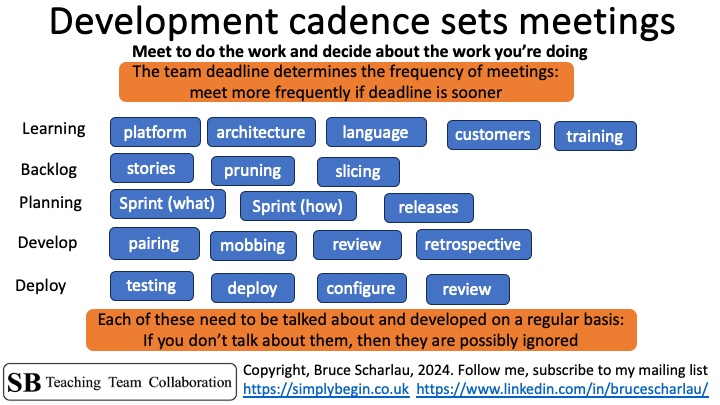Meet when you need to do the work and make the decisions that lead to the work
Student teams seem to think the work will magically happen if everyone does their bit. It will, as long as everyone sets aside time to do the work, and also turn up for meetings. I always remind students that the meetings aren’t always about planning. They need to plan when to meet to ‘do the work’ too. I wrote about this to some extent in a previous post. This time I want to focus on the variety of meetings.
Depending upon how the team organise their work, they will also need to pair and hopefully mob on parts too. If they work is organised along features as discussed previously, then these people need to meet to do the work.
Teams need meetings about the meetings
As you can see below, there are lots of topics the team should be talking about and deciding on, in their regular meetings. You should also see that some of these are work meetings too, that happen as part of an agile process.

I’m not sure if I have the right labels on the left, but hopefully you see that there are a range of issue areas to discuss, and that these break down into the topics listed in white on blue backgrounds. Learning here is anything the team needs to explore and maybe try before they decide.
All of this goes back to this: the students need to coordinate their work in a collaborative manner because most of what they need to do has less to do with the ‘work’ itself, and more about organising their work as discussed in the ‘collaboration phases‘. They can’t ‘scatter the work and gather the results’. They need to work collaboratively to increase the likelihood of success.
This means scheduling meetings to organise the team, plan their work, discuss progress, and how they will do the work, as well, as mentioned above meetings to do the work. Where possible, students need to organise their work in a way that offers fast feedback, so the team learns faster.
Use this in your classroom
As you talk to your student teams ask them about their meetings. I do this slowly, with one team at a time during practical lab sessions. You could also do this as a classroom exercise, if you ask each team to discuss the topic together, or in a lecture session with neighbours talking to each other.
Find out about the variety of meetings they run to see what is common in your classroom. You can also ask them ‘when’ the work happens, and how often they pair, or mob as a team. If they’re not pairing and mobbing, then ask how the solo work is going. Also ask how much rework happens with the solo work too.
I also find this is a slow realisation topic. I ask lots of questions of the teams, and then they slowly realise they can do things differently to gain different results. They can schedule meetings to do the work, they can use notifications in their calendars, and all of the other tools to make remembering easier. They will also realise this too is part of the collaboration.
This post is part of a project pulling together my materials and ideas about Teaching Team Collaboration: the Human-Side of Software Development for software development to students.
If you’d like to be notified of future posts, then please sign up for more using the adjacent form. When you sign up, then I’ll send you a free copy of the collaboration rules as a PDF from the book. You can also follow me on LinkedIn
The ideas above are from my book 101+ Ideas to Improve Team Collaboration, which covers all of these little things that students can do to improve their collaboration.